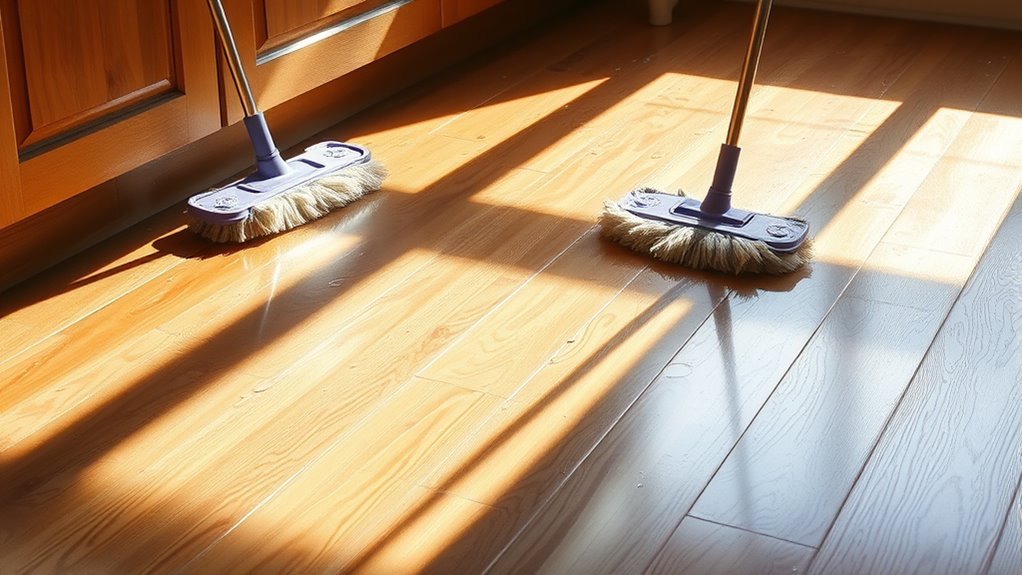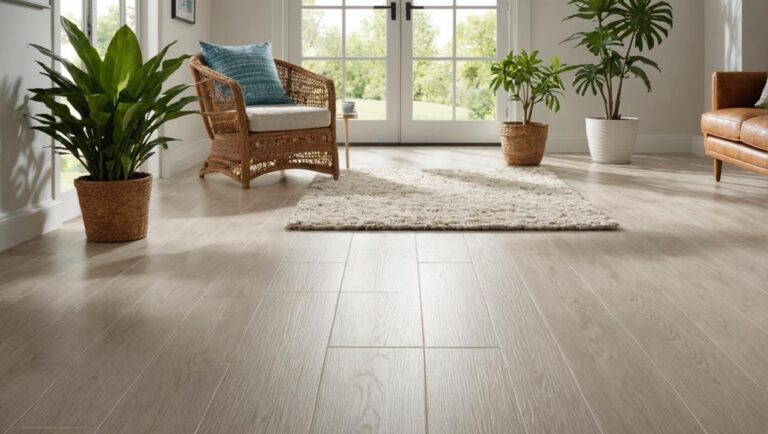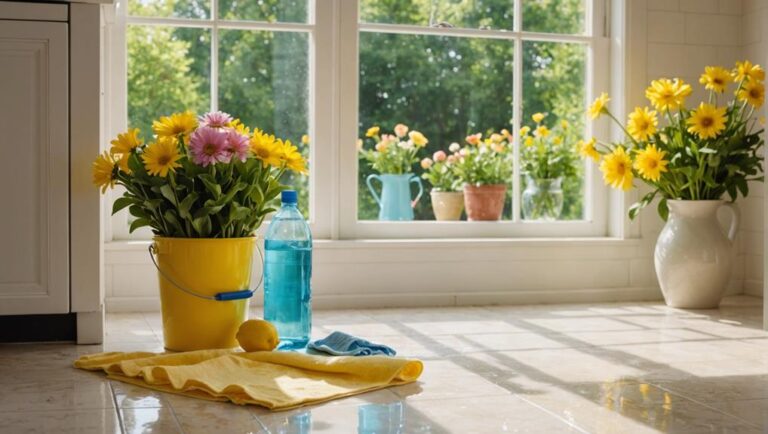You don’t always have to rinse Pine-Sol off floors, especially if they’re sealed surfaces like tile, vinyl, or hardwood. On these, Pine-Sol cleans effectively and leaves a protective layer without damage. However, if your floors are unsealed wood or waxed, rinsing is important to avoid dullness or buildup. Skipping rinsing on porous floors can cause stickiness and attract dirt. Keep going to discover when rinsing matters most and how to care for different floor types safely.
Understanding Pine-Sol and Its Cleaning Properties
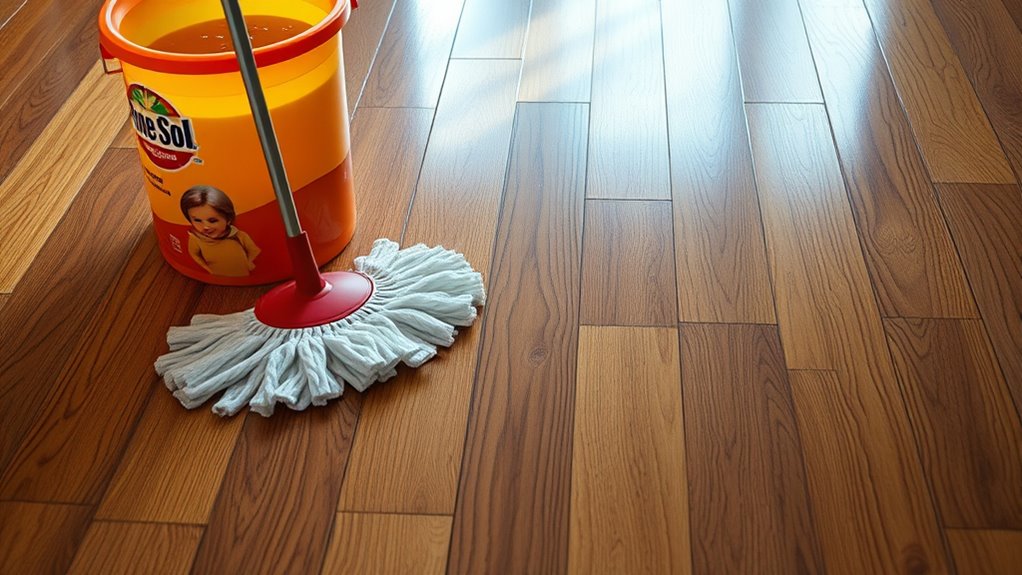
Although you might know Pine-Sol as a popular household cleaner, understanding its chemical makeup and cleaning properties can help you use it more effectively. Pine Sol ingredients primarily include surfactants, pine oil, and solvents. These components work together to break down grease, grime, and dirt on various surfaces. The pine oil provides a natural disinfectant quality, while surfactants lift and suspend debris for easy removal. This combination guarantees strong cleaning efficacy without harsh abrasiveness. Knowing this helps you apply Pine-Sol confidently, maximizing its performance. You’ll appreciate that its formula balances power and safety, allowing you to clean thoroughly while preserving your floors. Understanding how Pine-Sol ingredients contribute to its cleaning efficacy frees you to make smarter choices in your cleaning routine.
How Pine-Sol Works on Different Floor Types
Knowing how Pine-Sol’s ingredients work together helps you understand why it performs differently on various floor types. Pine-Sol effectiveness depends largely on floor compatibility. For example, it works well on sealed hardwood, tile, vinyl, and linoleum, cutting through grease and grime without damaging the finish. However, on unsealed wood or waxed floors, it might dull the surface or cause buildup. When you use Pine-Sol on ceramic or stone tiles, it cleans effectively but may leave a residue if not wiped properly. You want to match the cleaner’s strength with your floor type to avoid damage. Understanding this balance lets you enjoy Pine-Sol’s full cleaning power while protecting your floors, giving you the freedom to keep your home spotless without worry.
The Importance of Rinsing After Using Pine-Sol
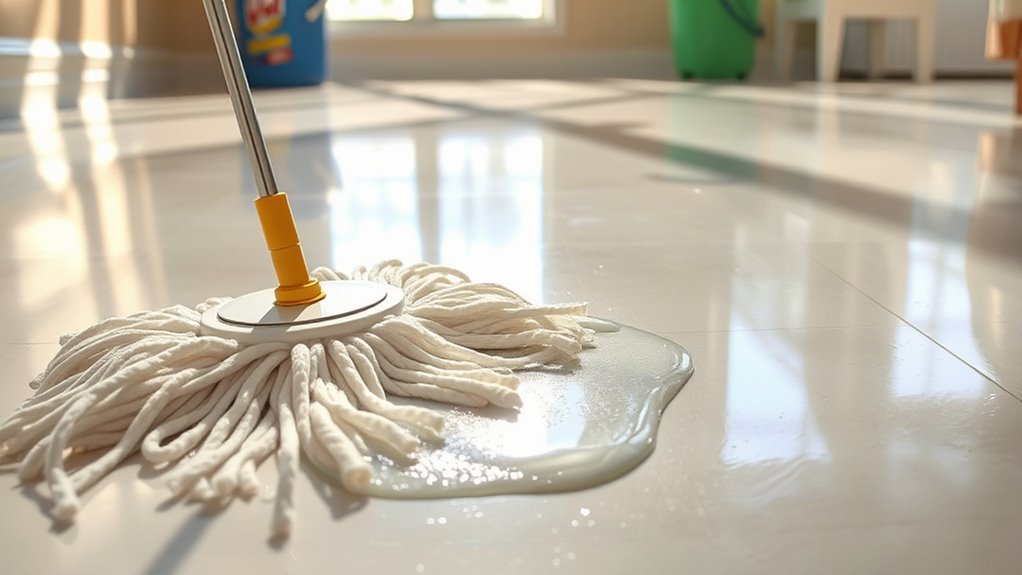
Since Pine-Sol is a powerful cleaner, rinsing your floors afterward is crucial to remove any residue that could attract dirt or dull the finish. Proper rinsing techniques improve cleaning effectiveness and protect your floor’s appearance by preventing buildup. You don’t want leftover cleaner compromising your freedom to enjoy spotless, gleaming floors. Here’s a quick guide to why rinsing matters:
| Avantage | Description | Result |
|---|---|---|
| Residue Removal | Washes away leftover cleaner | Prevents dirt attraction |
| Surface Protection | Avoids dulling or damage | Maintains floor shine |
| Hygiene | Removes bacteria and germs | Guarantees a truly clean floor |
Rinsing guarantees you maximize Pine-Sol’s power while keeping your floors looking fresh and vibrant.
When It’s Safe to Skip Rinsing
You can skip rinsing Pine-Sol on sealed, non-porous surfaces like tile or vinyl floors where residue won’t cause damage. Not rinsing saves time and leaves behind a protective layer that helps repel dirt. Just be sure the floor is properly sealed to avoid any buildup or stickiness.
Surfaces Suitable for Pine-Sol
Three common surfaces where you can safely skip rinsing after using Pine-Sol are sealed hardwood, ceramic tile, and vinyl floors. These suitable surfaces offer excellent cleaning compatibility with Pine-Sol’s formula, allowing you to enjoy a thorough clean without the extra step of rinsing. Sealed hardwood resists moisture and prevents residue buildup, while ceramic tile’s non-porous finish handles Pine-Sol effortlessly. Vinyl floors, known for durability, also maintain their integrity without needing a rinse. However, always confirm your floor’s finish and manufacturer recommendations to verify cleaning compatibility. By understanding which surfaces are suitable, you gain more freedom in your cleaning routine, saving time and effort without compromising on cleanliness or floor care.
Benefits of No Rinse
When it’s safe to skip rinsing Pine-Sol off your floors, you’ll save time and simplify your cleaning routine. The no rinse benefits include less effort and quicker results, letting you move on to other tasks without lingering moisture or residue. This time saving convenience is especially valuable when cleaning large areas or frequent touch-ups. You don’t have to worry about additional water use or drying time, making your process more efficient and eco-friendly. Just verify your floor type is compatible—such as sealed hardwood or tile—before skipping the rinse. By understanding when no rinse is appropriate, you gain freedom from unnecessary steps while maintaining a clean, fresh floor. Embracing this approach streamlines your routine and maximizes your cleaning efficiency.
Step-By-Step Guide to Mopping With Pine-Sol
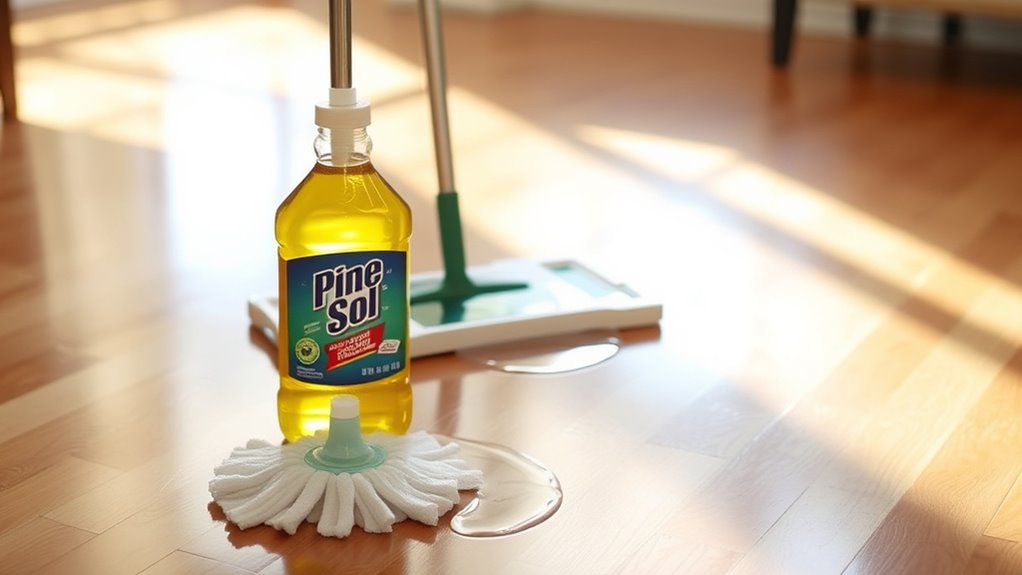
Although Pine-Sol is a powerful cleaner, mopping with it requires the right technique to avoid residue buildup and guarantee your floors shine. Follow these mopping techniques for effective floor care:
- Dilute Pine-Sol as directed—usually 1/4 cup per gallon of warm water—to make sure safe, effective cleaning.
- Sweep or vacuum first to remove loose dirt and debris for a cleaner mop job.
- Mop the floor using a damp mop, applying the Pine-Sol solution evenly without soaking the floor to prevent excess residue.
- Allow the floor to air dry. Since Pine-Sol doesn’t require rinsing, this saves time and keeps your floors gleaming without sticky buildup.
Stick to these steps, and you’ll enjoy clean, fresh floors with minimal effort and maximum freedom.
Potential Risks of Not Rinsing Pine-Sol Residue
While Pine-Sol is designed to be used without rinsing, skipping this step can sometimes leave behind residue that affects your floor’s appearance and safety. Pine Sol residue can dull your floors, make them sticky, and even reduce cleaning efficiency over time. This buildup may also create slippery surfaces, posing a safety risk.
| Risk Type | Cause | Effect on Floor |
|---|---|---|
| Apparence | Pine Sol residue | Dull, sticky finish |
| Cleaning Efficiency | Residue buildup | Less effective future cleaning |
| Safety | Slippery residue | Increased slip and fall risk |
| Entretien | Residue accumulation | More frequent deep cleaning required |
| Durabilité | Chemical residue | Potential long-term floor damage |
To keep your floors looking fresh and safe, consider the impact of Pine Sol residue.
Tips for Maintaining Clean and Safe Floors
To keep your floors clean and safe, use Pine-Sol according to the label’s instructions and avoid overapplying. Make sure to follow safety precautions like proper ventilation and keeping the floor dry to prevent slips. Using effective cleaning techniques, such as rinsing thoroughly and drying completely, will help maintain your floors’ condition.
Proper Pine-Sol Usage
When using Pine-Sol on your floors, it’s important to follow the proper dilution guidelines to avoid residue buildup and guarantee effective cleaning. Sticking to recommended ratios assures your floors stay spotless without sticky films. Also, consider your cleaning frequency—overuse can lead to unnecessary buildup.
Here’s how to get the most out of Pine-Sol:
- Mix Pine-Sol with water following label instructions for proper dilution.
- Clean floors regularly but not excessively; adjust frequency based on traffic.
- Use a microfiber mop to distribute solution evenly and pick up dirt.
- Let floors air dry to prevent streaks without needing a rinse.
Floor Safety Precautions
Although keeping your floors spotless is essential, ensuring they remain safe to walk on is just as important. When doing floor cleaning, you must follow key safety measures to prevent slips and damage. Use proper signage to warn of wet floors, and avoid over-wetting surfaces, especially with Pine-Sol. Dry floors promptly to maintain traction.
| Safety Measure | Reason | Your Action |
|---|---|---|
| Use Wet Floor Signs | Prevents accidental slips | Place visibly during cleaning |
| Control Moisture | Avoids slippery surfaces | Apply cleaning solution sparingly |
| Dry Thoroughly | Maintains floor traction | Use mop or towel after cleaning |
Following these precautions lets you enjoy clean floors without risking injury or damage.
Effective Cleaning Techniques
Keeping floors safe during cleaning sets the foundation for effective techniques that both preserve cleanliness and protect your surfaces. To maintain spotless, damage-free floors, you need effective strategies and the right cleaning tools. Here’s how you can do it:
- Choose appropriate cleaning solutions, like Pine-Sol, diluted as recommended to avoid residue buildup.
- Use microfiber mops or soft cloths that trap dirt without scratching your floors.
- Clean in sections, rinsing tools regularly to prevent spreading dirt or cleaning agents.
- Allow floors to air dry or use a dry mop to speed up drying and prevent slips.
Alternatives to Pine-Sol for Sensitive Flooring
Si votre sol is sensitive to harsh chemicals, you’ll want to contemplate gentler cleaning options than Pine-Sol. A simple vinegar solution—mix equal parts water and white vinegar—is effective for many surfaces without causing damage. It disinfects and removes grime while being safe for delicate flooring. For added care, you can apply a light coating of coconut oil after cleaning to condition wooden floors and maintain their shine. This natural oil protects the finish and prevents drying or cracking. Avoid abrasive cleaners that might strip your floor’s protective layer. These alternatives give you freedom to clean thoroughly without worrying about harming sensitive materials, ensuring your floors stay beautiful and intact over time.

